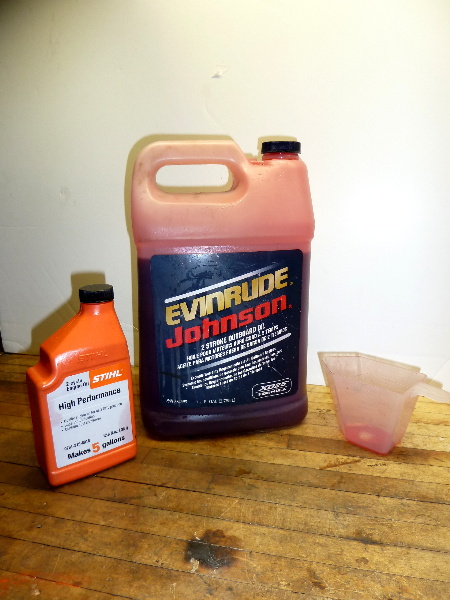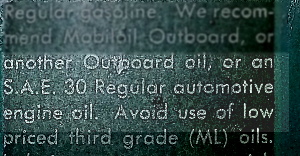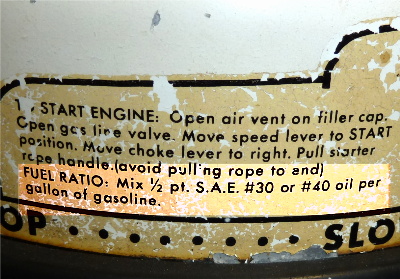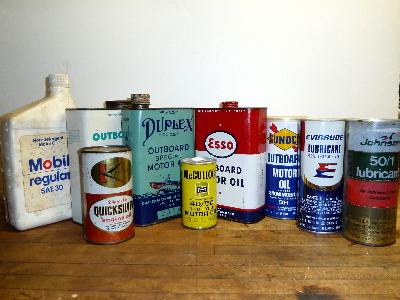|
Tech
Tip #5 - 2-Cycle Oil And You!
Advice is like castor oil, easy enough to give but dreadful uneasy to take. - Henry Wheeler Shaw
The below represents the proprietor's thoughts on 2-stroke oils but please note: I'm not an engineer, don't work for an oil company or any outboard manufacturer. However, I have owned or worked on literally thousands of old outboards, most of which were manufactured prior to 1960. So I've seen almost any kind of problem that can come up - issues related to oil (or lack thereof) are some of the most serious.
It is no surprise that there are so many questions on oil mix. There is a ton of bad information circulating in regards to what people with older outboards (i.e. pre-1965 - and some after that) should use for fuel mixtures. Some of this info is from mechanics who simply don't know any better since most outboards manufactured since the mid 1960s typically required a 50:1 mix - they think that's the norm for EVERYTHING. One of the worst sources of bad information came direct from OMC back in the 1970s - weather this was a deliberate effort to destroy older pre-1965 motors so they could sell new ones, or simply not enough research, we'll never know. I'm referring here to the 1970's OMC Service Bulletin stating 50:1 with OMC oil was okay in all their motors basically back to the dawn of time. And then let's not leave out the oil manufacturers who also make their own snake-oil claims.
Our opinion is that we are only a temporary custodian of this old equipment – our hope and responsibility is that these motors will be around for many future generations to enjoy. To that end, we run only quality name brand oil in all our equipment and at the original mixture ratio - or heavier. Knowing a bit about the motor in question and the correct oil to use is critical.

Stihl air-cooled "TC" oil and Johnson / Evinrude TCW-3 oil for water-cooled motors
|
Type of 2-Stroke Oil: There are two types of two stroke oil currently available:
- TCW-3 is the rating for water cooled outboards. (This means Two Stroke Water cooled version 3) Most outboards are water cooled so this is the most common oil found.
- TC oil is for air cooled 2-cycle motors and typically intended for use in weedwackers and chain saws. Air cooled outboards were mostly small hp rigs and were common from the 1930s to the 1970s. We are not aware of any (new) air-cooled outboards on the market today.
Why two types of oils? Well, the main reason is that water cooled engines run a lot cooler than air cooled ones. Depending on the temperature of the water and air, the difference in cylinder operating temperatures for these two types of motors could be over 200+ degrees! The temperature an outboard runs at creates special problems for combustion of the 2-stoke oil, proper lubrication of the piston and rings and the problem of residue in the combustion process. Another issue is that water cooled outboards tend to exhaust into the water and most air-cooled ones into the air - each of these things gives engineers special headaches.
In water cooled outboards we use TCW-3 from Johnson/Evinrude, Mercury or Yamaha. For air cooled outboards we use oils rated TC from Golden Spectro or Stihl. (Note - certain model Clinton and Eska motors are both air AND water cooled, we use air-cooled oil in them.) |
We avoid oil that says it's okay in both air and water cooled motors. These tend to be very cheap or very expensive oils. Can't imagine they do the job as well as the correct oil: jack of all trades - master of none!
IMPORTANT: Never use modern oil intended for a 4-stroke car in 2-stroke equipment – it will destroy it. Yes, sure, the instruction manual or decal on a 50-75-100 year old motor may say "use SAE 30" but that was before detergents were in 4-cycle oil and before good 2-stroke oils were developed. That was then, this is now - today car oil is totally unacceptable.
|
|
 |
 |
| DON'T DO IT! - even though the decal on the "55 Johnson 5.5hp (left) and 1962 Elgin 2hp (right) say SAE 30 is okay, you should NOT do this today.
You should use modern 2-cycle oil (TCW-3 for the Johnson and TC for the Elgin) at the indicated ratio. |
We have seen many, many, old motors ruined from the use of cheap, inappropriate or simply not enough oil. While name-brand oils do cost more, any good mechanic will confirm that a quality oil not only reduced friction but also; burns cleanly and leaves no ash/coke in the combustion chamber or in the exhaust. The few dollars more for a good oil is a small price to pay to prevent major mechanical issues.
Oil Ratio:
The ratio of oil to gas is different for almost every outboard manufacturer and even from one model to another. Most motors manufactured before 1960 require at least ½ pint per gallon of gas with some needing ¾ (or more) of a pint per gallon. If your motor still has the oil decal or you have the manual noting the recommended mix, follow those guidelines using the correct type of modern 2-stroke oil. (*See Note below) Again DO NOT use automotive oils in an outboard, (even if the original decal says so), they were different from what is available today. If you don't know the ratio for your motor, look around this website and see if we have the same or similar model - almost all of our data cards indicate the original gas/oil mix that was recommended. Yes, we know that in many cases this may be a lot of oil and it may be a little smoky when running, but that's just how it is. Remember: more oil does no harm but too little can be devastating. Whenever one is in doubt about what the ratio should be for a particular motor, posting the question on the AOMCI Ask A Member board will often yield an answer.
* NOTE: Of course the one exception to the rule of following the recommended mix in the instruction manual or on the decal is if you are unfortunate enough to have one of OMC's 100:1 motors made in the mid 1980s (a pretty new antique in our opinion) No 2-stroke outboard should ever be subjected to 100:1 and OMC learned their lesson with zillions of replacements under warranty and reverted back to 50:1 for those models. Please NEVER run a motor at 100:1 and avoid buying one unless you are sure it hasn't been!
|
Why So Much Oil?
A lot of people question why use such a rich mixture since the oil today is superior to that available 40, 50, 75, 100 years ago? There are a lot of compelling reasons:
1) Most outboards made prior to 1965 (and some afterwards) use bronze bushings on the crankshaft, connecting rods or wrist pins. These need a lot of oil to function properly.
2) Despite the changeover to needle and roller bearings on many motors starting in the 1950s, many continued to use bronze inserts as crankcase seals. These are cast into the block and are not replaceable. (Unless you have unlimited credit with your local machine shop!) The 2-stroke mixture serves two purposes here, first to lubricate and second to help the seal do its job.
3) In addition to the crankshaft, connecting rods and bearings, the most basic job of 2-cycle is to prevent wear in the cylinder. Engineers of 2-cycle motors define two specific types of wear: Abrasive Wear and Adhesive Wear, you should know these terms:
Abrasive Wear: As a 2-cycle motor runs, the bearings, cast iron piston rings, piston and cast iron cylinder wall are in a violent war with each other. The oil acts as a cushion and the proper oil film helps prolong the life of the components. Take apart a high hour 2-cycle motor and you will see the parts appear to have been sanded or polished - this is normal abrasive wear. While some abrasive wear is inevitable, we have seen outboards with over 2,000 hours of service showing very little abrasive wear thanks to the proper oil and mix ratio being used.
Adhesive Wear: When a 2-cycle is run with insufficient oil, the war between the piston, rings and cylinder wall really heats up - quite literally! Excessive heat and friction cause particles from the softest metal (typically the aluminum piston) to be removed and then bonded to the cooler areas. These particles build up and create even more heat and friction. This is a vicious cycle of more and more wear and heat until the motor simply seizes up or just will not run.
So in a nut-shell, use of a good oil at the proper ratio helps keep things lubricated, properly sealed and will help hold off abrasive wear and prevent adhesive wear.
|
| Vintage oil cans are great - vintage oil is not! Leave the old oil for display purposes only, do not attempt to use it in your outboard. |
Please use common sense when working
on anything involving gasoline. Practice good shop techniques
and work safely and cleanly. Don't forget to visit our DISCLAIMER
before you contemplate doing anything presented on this website.
|




